3rd December 2007
 Tuesday, December 4, 2007 at 09:59PM
Tuesday, December 4, 2007 at 09:59PM Just after midday, the Mtito River came down in a roaring flood, much higher than the one of November 22nd. My father and I rushed off to see if we could catch one of the other sand luggas coming down in a flash-flood. We took our fast-food lunch (ie a mango) and sat under a tree waiting for the water for about half and hour. It didn’t come.
We cut our losses (though I did photograph the terminalia brownii in pod and in flower – gorgeous white blossoms) and drove around to the river crossing, where the road crosses a natural rock causeway and enters the Tsavo National Park. The river was raging here – bright red – as it was at the “dam” further downstream. (The old Hammerkop nest did not seem to be seeing any action – perhaps they’ve given up on that idea.)
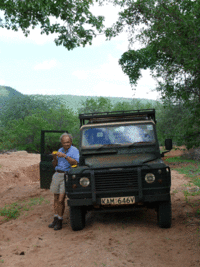
Dad and his measly mango lunch
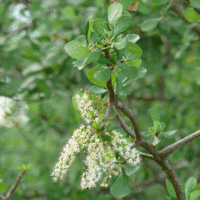
Terminalia brownii Flowers (click to enlarge)
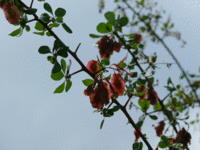
Pods of terminalia brownii
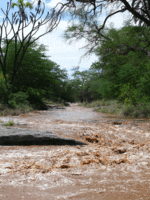
Upstream from the Mtito crossing
During the afternoon, I was able to watch from the house as the level of the Mtito ebbed and flowed, every now and then a fresh wave of water rushing down, raising the river level higher and higher. Even though the Athi was still flowing fairly strongly after last night’s flood, you could see the streams of new water from the Mtito flowing out into it.
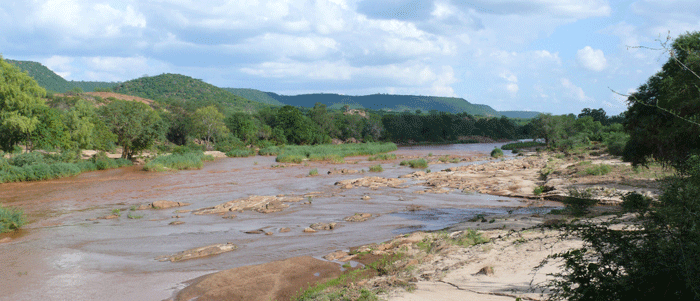
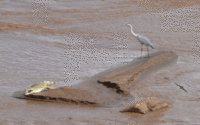 The arrival of the new water triggered an afternoon of non-stop action on the river. The birds started to congregate, busy with fish and insects: the oh-so-elegant Grey Heron, which was sharing a sand island with a couple of crocodiles, and then with a Hammerkop, the ever-present Spur-winged Plovers, the Spotted Redshank (yes, a new one for the bird species list, now numbering over 157!) plus various Sandpipers, the Pied Wagtails, and the Pied Kingfishers too – all converging for a feast, all either snatching fish from the turbulence or snatching insects fleeing from the rising water. The crocodiles started gathering, sly and silent, waiting for their chance to go up into the new river and seek fishing grounds further upstream.
The arrival of the new water triggered an afternoon of non-stop action on the river. The birds started to congregate, busy with fish and insects: the oh-so-elegant Grey Heron, which was sharing a sand island with a couple of crocodiles, and then with a Hammerkop, the ever-present Spur-winged Plovers, the Spotted Redshank (yes, a new one for the bird species list, now numbering over 157!) plus various Sandpipers, the Pied Wagtails, and the Pied Kingfishers too – all converging for a feast, all either snatching fish from the turbulence or snatching insects fleeing from the rising water. The crocodiles started gathering, sly and silent, waiting for their chance to go up into the new river and seek fishing grounds further upstream.
And then the mother and baby hippo emerged from the reeds on the opposite side of the river from the house, and made their way across the rushing red main channel of the Athi, until they reached the point half way across where the new water from the Mtito was spilling into the bigger river. The mother hippo kept opening and closing her mouth, snapping at the water, as if she was tasting it, while her baby merely frolicked and bobbed in the turbulence like an over-sized cork. They only stayed in the middle of the river for a couple of minutes, before heading back over the other side, and under the reeds again.
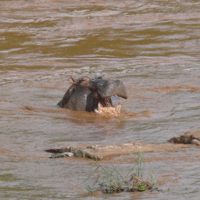
Mother hippo "tasting" new water?
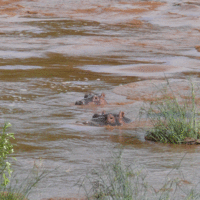
Mother & Baby Hippo, mid-river
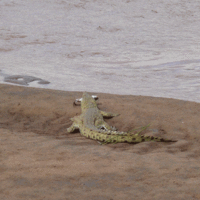
Small Croc; Big Fish (click any image to enlarge)

Fish impaled in top of croc's mouth
A small crocodile caught a large fish, which it then tried to eat… which turned out to be a lengthy process. The crocodile crawled out onto one of the sand islands, fish in mouth, and tried to swallow it. Crocodiles cannot chew, so it had to try to swallow the fish whole. Easier said than done, when you’re a small crocodile with a large fish. At one stage, the fish had almost completely vanished into the crocodile’s mouth, and the crocodile slid back into the river. Show over, I thought and turned to go back indoors. I’m not sure what made me look back, but as I glanced out at the river, the crocodile leapt fully out of the water, shaking its head as it did so, and landing back in the water with a huge splash. Typical: I had sat watching the crocodile for a long while, but then, just as I abandoned my watch, thinking it was all over, the real action happened, and I missed the definitive shot of the day. I felt frustrated for quite a while afterwards, but what can you do? By the time you’ve missed it, it’s too late and you never get the chance for a replay with wildlife photography – that’s what makes it so exciting and so frustrating.
After its brief acrobatics, the crocodile then crawled back onto the island, and I could see it still hadn’t swallowed the fish – in fact, the fish was stuck to the roof of the crocodile’s mouth. Suddenly it all made sense: the fish, which the crocodile was attempting to swallow, was one of those which have a dorsal spike, and this spike had impaled itself in the roof of the crocodile’s mouth. By leaping in the air and shaking its head, the crocodile was trying to dislodge the spike (which must have been painful too), so it could swallow its meal. It took a long time (revenge of the preyed upon), but eventually the little crocodile did succeed. Meanwhile, the Spur-winged Plover was hovering nearby (chasing every other bird in its vicinity – in this case, the Common Sandpipers) and fuelling the legend (which is totally unfounded) that Plovers pick clean the teeth of crocodiles.
When the Mtito River flows, the crocodiles make their way up the river to the falls and rapids which are about three or four hundreds yards upstream from the confluence with the Athi. Here they lie in pools, or at the base of the falls, hunting for fish, either trapped in the pools or heading upstream to spawn. You can see the fish jumping, trying to get up the falls. When the fish are on the move, the crocodiles lie at the base of the falls and just swallow whichever hapless fish fall back off the water-rushing rock-face into their mouths (tough life, being a crocodile).
At around 5pm, we walked upstream from the house, and perched on a cliff edge, with a good vantage point over the Mtito, to see what we could see. The crocodiles had not reached the main falls yet but we did see a couple of big ones, just at dusk, moving upstream. Tomorrow morning, without a doubt, they’ll be there…
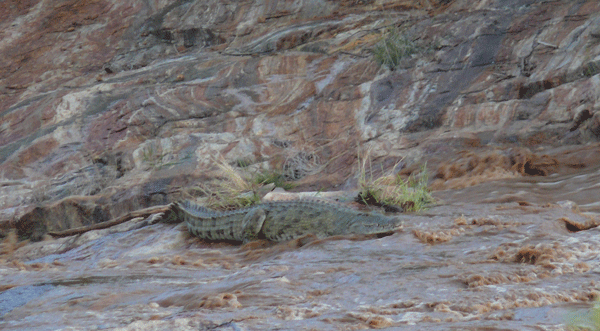





Reader Comments (2)
Dear Tanya:
I thought when I saw the picture of the gentleman eating the mango "that looks like Simon Trevor". I didn't realize until checking your bio that you were Simon's daughter.
I have had the privilege of meeting your Father several times at Tsavo. I have since been trying to convince him to put all his Tsavo movies on DVD's and sell them. I would dearly love to buy them here in the U.S. Perhaps you can give him a shove in that direction.
I have loved looking at your photography on your blog. Wonderful job. And, I envy your new home. I know you and Ian will be so happy there. How far are you from Ithumba? I have been there and stayed at Sheldrick Camp to see my elephant orphans. It is truly gorgeous country. I envy you.
Despite the travel warnings, I'm heading for Kenya in three weeks and will have the privilege of staying at Satao in Tsavo for nine days. I understand it is still beautifully green and can't wait to get there.
All the best to you and Ian.
Dear Jan:
Lovely to hear from you. What a coincidence that you have met my father and are such a Tsavo-lover! I am delighted to hear that you are still coming to Kenya, despite the problems. I think the press have over-exaggerated the scale of the troubles here - certainly up until now, the troubles have been in isolated pockets and not countrywide as one would think when listening to the press reports. There is an overwhelming feeling here that people have had enough of the nonsense perpetrated by the politicians, and just want to get on with their lives.
Back to Tsavo: Our house is just over the Yatta Plateau from Ithumba - not so far really, although quite a rough drive! You have to cross the Athi River, then go over the top of the Yatta and from there north-eastwards towards Ithumba.
My father is still living in Tsavo, near Voi, so we may well be able to meet up when you are at Satao. In the meantime, you may be interested to take a look at the African Environmental Film Foundation, the non-profit foundation set up by my father ten years ago, to make educational films about environmental issues in Africa. As well as new films made by the Foundation, my father's older films are also available through the Foundation. You can read all about them on the website. At the moment, the films are available for free to educational institutions and conservation organizations, but we are also working on setting up a system for selling the films. As soon as that happens, we will post the details on the Foundation website.
I hope you have a very special visit to Kenya - Tsavo is drying out fast after the rains, so it may not be bright green when you get there - but that is better for game-viewing as the animals start returning to the permanent water sources (like the Satao waterhole) when the land starts drying out...so you should see more animals than in the middle of the rainy season when everything is very spread out.
With best wishes,
Tanya